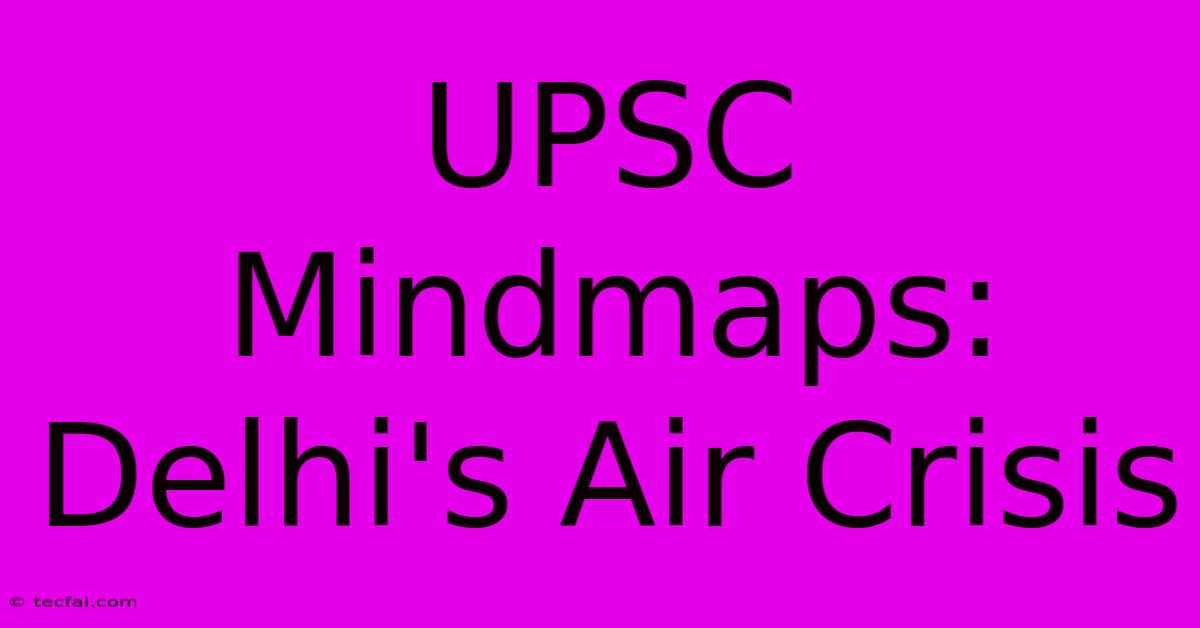UPSC Mindmaps: Delhi's Air Crisis

Discover more detailed and exciting information on our website. Click the link below to start your adventure: Visit Best Website tecfai.com. Don't miss out!
Table of Contents
UPSC Mindmaps: Delhi's Air Crisis
Delhi's air quality consistently ranks among the world's worst, posing a significant public health and environmental challenge. This issue is not just a local concern; it's a national one with implications for the UPSC exam, particularly in the Geography, Environment, and Current Events sections. Understanding the complexities of Delhi's air crisis requires a multi-faceted approach, and mind-mapping can be an invaluable tool for organizing information effectively.
Understanding the Problem: A Mind Map Approach
A central concept mind map for "Delhi's Air Crisis" could have the following branches:
Central Idea: Delhi's Air Crisis
Main Branches:
-
Sources of Pollution: This branch would delve into the various contributors to Delhi's poor air quality. Sub-branches could include:
- Vehicular Emission: Focus on the type of vehicles, traffic density, and emission standards.
- Industrial Emissions: Highlight major industrial sectors, their pollution control measures (or lack thereof), and geographical location.
- Construction Activities: Discuss dust pollution from construction sites and mitigation strategies.
- Waste Burning: Address the issue of municipal solid waste burning and its impact.
- Agricultural Burning (Stubble Burning): Explain the role of stubble burning in neighboring states and its contribution to Delhi's pollution.
- Seasonal Factors: Highlight the impact of weather patterns (inversion layers) and seasonal changes on air quality.
-
Health Impacts: This branch focuses on the consequences of poor air quality on public health. Sub-branches could include:
- Respiratory Diseases: Discuss the increase in asthma, bronchitis, and other respiratory illnesses.
- Cardiovascular Diseases: Explain the link between air pollution and heart problems.
- Mortality Rates: Present data on increased mortality linked to air pollution.
- Child Health: Highlight the vulnerability of children to air pollution.
-
Government Initiatives and Policies: This branch examines the measures taken by the government to tackle the crisis. Sub-branches could include:
- Odd-Even Scheme: Analyze the effectiveness and limitations of the odd-even vehicle rationing policy.
- Pollution Control Laws: Discuss existing environmental laws and their enforcement.
- Green Initiatives: Highlight government efforts towards promoting green spaces and sustainable transportation.
- International Collaboration: Explore collaborative efforts with other countries to address transboundary pollution.
-
Technological Solutions: This branch explores innovative solutions to address the problem. Sub-branches could include:
- Air Purifiers: Discuss the role of air purifiers in mitigating indoor air pollution.
- Emission Control Technologies: Highlight advancements in vehicle emission control and industrial pollution reduction technologies.
- Renewable Energy Sources: Explore the shift towards renewable energy to reduce reliance on fossil fuels.
-
Public Awareness and Participation: This branch emphasizes the importance of public awareness and engagement. Sub-branches could include:
- Public Campaigns: Discuss the role of awareness campaigns in educating the public.
- Citizen Science: Highlight the use of citizen science initiatives in monitoring air quality.
- Community Involvement: Discuss the participation of local communities in addressing the issue.
UPSC Exam Relevance
Delhi's air crisis is a recurring topic in the UPSC exam. Using a mind map allows for a comprehensive understanding of the issue, enabling you to answer questions effectively. The interconnectedness of the various branches highlights the complex nature of the problem and facilitates a nuanced understanding, crucial for scoring well in the exam.
Key Terms for UPSC Preparation:
- Particulate Matter (PM2.5 and PM10): Understand their sources, health effects, and measurement.
- Air Quality Index (AQI): Know how it's calculated and interpreted.
- National Clean Air Programme (NCAP): Be aware of its goals, strategies, and implementation.
- Graded Response Action Plan (GRAP): Understand its various stages and measures.
- Transboundary Pollution: Know its implications and international cooperation efforts.
By creating and regularly reviewing a mind map on Delhi's air crisis, you can effectively organize your knowledge, improve your understanding of the issue, and enhance your performance in the UPSC exam. Remember to use credible sources and update your mind map with the latest developments. This structured approach not only aids in knowledge retention but also reflects a systematic and analytical approach, highly valued by the UPSC examiners.

Thank you for visiting our website wich cover about UPSC Mindmaps: Delhi's Air Crisis. We hope the information provided has been useful to you. Feel free to contact us if you have any questions or need further assistance. See you next time and dont miss to bookmark.
Featured Posts
-
Inside Sharon Horgans Family
Nov 23, 2024
-
Donegal Road Crash Serious Incident
Nov 23, 2024
-
New Peter Kay Tour Date Isle Of Man
Nov 23, 2024
-
Anna Samson Romance Beyond Paradise
Nov 23, 2024
-
Ohio Dominican At Cleveland State Womens Hoops
Nov 23, 2024
